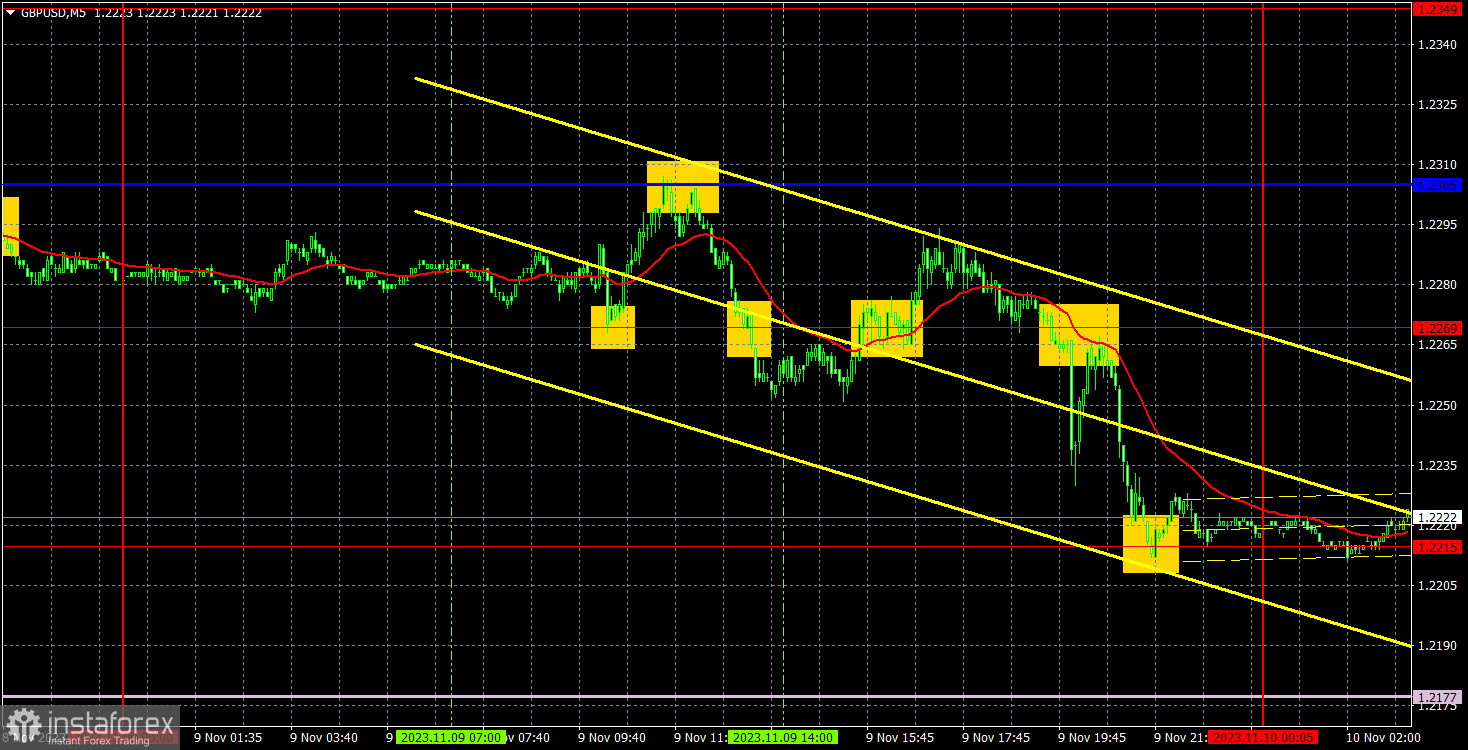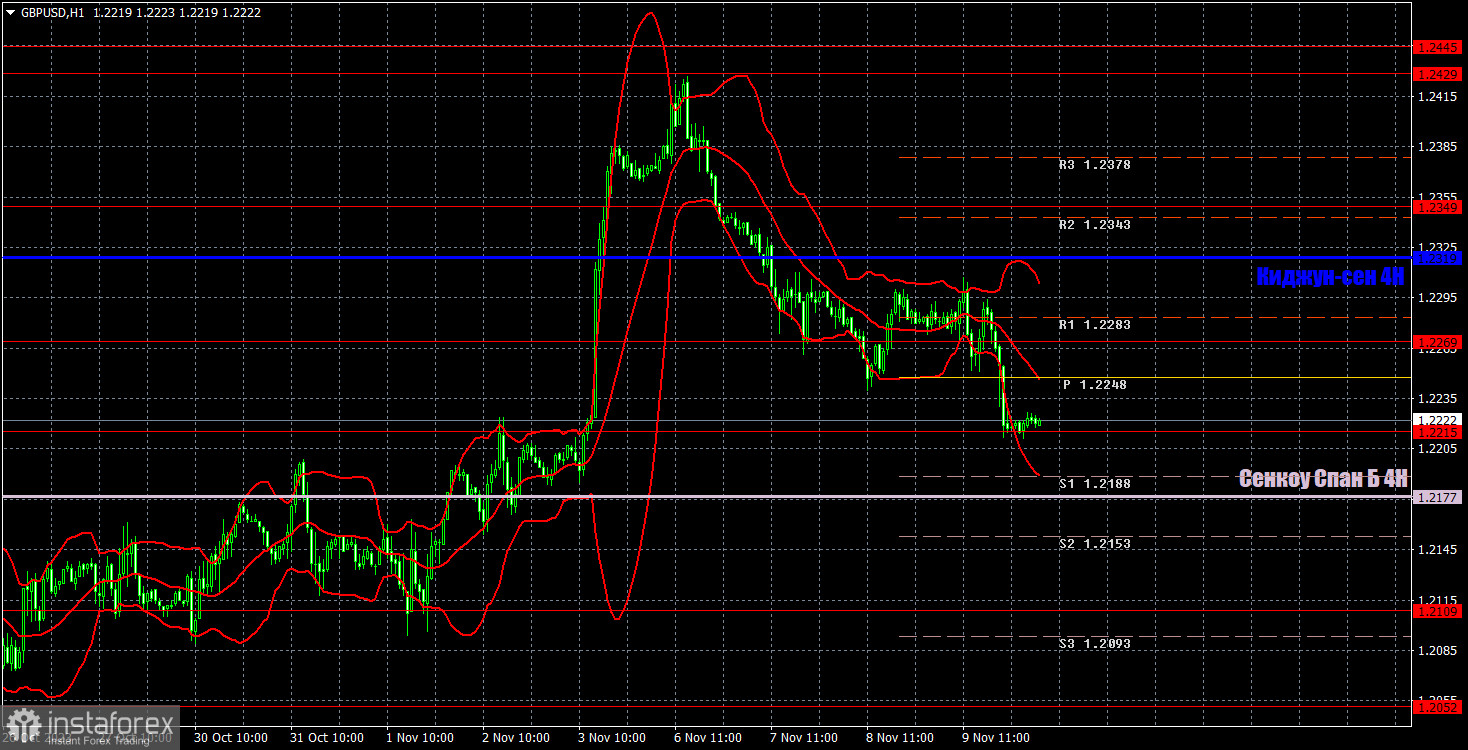Analysis of GBP/USD 5M

On Thursday, GBP/USD also traded lower and was in disarray. Throughout the day, the price repeatedly rebounded upwards, but each time, it fell. We can't say that the pair was pulled down by macroeconomic or fundamental factors, but Federal Reserve Chair Jerome Powell's statement can be described as "moderately hawkish." While he did not convey anything fundamentally important to the market, he did say that the Fed will not hesitate to tighten more "if the situation requires it," which is much better than the categorical "no" from other Fed officials. Thus, the British pound fell again, which fully corresponds to our expectations. Recall that we expect the medium-term downtrend to resume. To begin with, the pair must descend to its recent local lows, which are around the 1.21 level.
There were quite a few trading signals formed yesterday, but not all of them were accurate and strong. The first two signals were profitable, but the movements were very weak. It was possible to earn a maximum of 20-25 pips on them. Then there were two false signals around the level of 1.2269, for which it was not even possible to set a Stop Loss to breakeven. Then there was a consolidation below the level of 1.2269, afterwards the price dropped quite sharply to the level of 1.2215, but it was no longer advisable to trade this movement since the two previous signals around 1.2269 turned out to be false. Overall, it was not the best trading day.
COT report:

COT reports on the British pound also align perfectly with what's happening in the market. According to the latest report on GBP/USD, the non-commercial group closed 3,400 long positions and 1,700 short ones. Thus, the net position of non-commercial traders decreased by another 1,700 contracts in a week. The net position indicator has been steadily rising over the past 12 months, but it has been firmly decreasing over the past three months. The British pound is also losing ground. We have been waiting for many months for the sterling to reverse downwards. Perhaps GBP/USD is at the very beginning of a prolonged downtrend. At least in the coming months, we do not see significant prospects for the pound to rise, and even if we're currently witnessing a corrective phase, it could persist for several months.
The British pound has surged by a total of 2,800 pips from its absolute lows reached last year, which is an enormous increase. Without a strong downward correction, a further upward trend would be entirely illogical (if it is even planned). We don't rule out an extension of an uptrend. We simply believe that a substantial correction is needed first, and then we should assess the factors supporting the US dollar and the British pound. A correction to the level of 1.1844 would be enough to establish a fair balance between the two currencies. The non-commercial group currently holds a total of 63,700 longs and 85,800 shorts. The bears have been holding the upper hand in recent months, and we believe this trend will continue in the near future.
Analysis of GBP/USD 1H

On the 1H chart, GBP/USD has finally formed an upward movement, which could serve as a convincing conclusion to the entire bullish correction, which has been ongoing for a month. The pair has started to fall, so now we're waiting for it to drop to the Senkou Span B line. In the future, we may see choppy movements within a limited price range, but in the medium-term perspective, we anticipate a downward movement.
As of November 10, we highlight the following important levels: 1.1760, 1.1874, 1.1927-1.1965, 1.2052, 1.2109, 1.2215, 1.2269, 1.2349, 1.2429-1.2445, 1.2520, 1.2605-1.2620, 1.2693. The Senkou Span B (1.2177) and Kijun-sen (1.2319) lines can also be sources of signals. Signals can be "bounces" and "breakouts" of these levels and lines. It is recommended to set the Stop Loss level to break-even when the price moves in the right direction by 20 pips. The Ichimoku indicator lines can move during the day, which should be taken into account when determining trading signals. The illustration also includes support and resistance levels that can be used to lock in profits from trades.
On Friday, the UK will release several reports. We will highlight the UK Q3 GDP data, which may fall by 0.1%. Industrial production should also be noted. Collectively, these two reports may impact the pound's movement, and most likely, in a negative way.
Description of the chart:
Support and resistance levels are thick red lines near which the trend may end. They do not provide trading signals;
The Kijun-sen and Senkou Span B lines are the lines of the Ichimoku indicator, plotted to the 1H timeframe from the 4H one. They provide trading signals;
Extreme levels are thin red lines from which the price bounced earlier. They provide trading signals;
Yellow lines are trend lines, trend channels, and any other technical patterns;
Indicator 1 on the COT charts is the net position size for each category of traders;
Indicator 2 on the COT charts is the net position size for the Non-commercial group.
 English
English 
 Русский
Русский Bahasa Indonesia
Bahasa Indonesia Bahasa Malay
Bahasa Malay ไทย
ไทย Español
Español Deutsch
Deutsch Български
Български Français
Français Tiếng Việt
Tiếng Việt 中文
中文 বাংলা
বাংলা हिन्दी
हिन्दी Čeština
Čeština Українська
Українська Română
Română

